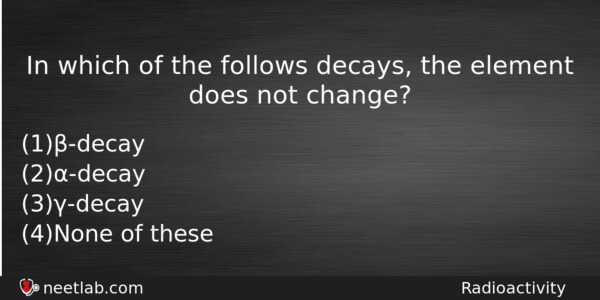| ⇦ | 
| ⇨ |
In which of the follows decays, the element does not change?
Options
(a) β-decay
(b) α-decay
(c) γ-decay
(d) None of these
Correct Answer:
γ-decay
Explanation:
No explanation available. Be the first to write the explanation for this question by commenting below.
Related Questions: - 6Ω and 12Ω resistors are connected in parallel. This combination is connected
- In the experiment for determination of velocity of sound in air,
- A man throws balls with the same speed vertically upwards one after the other
- Photocells convert
- A proton beam enters a magnetic field of 10⁻⁴ Wb/m² normally. If the specific charge
Topics: Radioactivity
(83)
Subject: Physics
(2479)
Important MCQs Based on Medical Entrance Examinations To Improve Your NEET Score
- 6Ω and 12Ω resistors are connected in parallel. This combination is connected
- In the experiment for determination of velocity of sound in air,
- A man throws balls with the same speed vertically upwards one after the other
- Photocells convert
- A proton beam enters a magnetic field of 10⁻⁴ Wb/m² normally. If the specific charge
Topics: Radioactivity (83)
Subject: Physics (2479)
Important MCQs Based on Medical Entrance Examinations To Improve Your NEET Score
18000+ students are using NEETLab to improve their score. What about you?
Solve Previous Year MCQs, Mock Tests, Topicwise Practice Tests, Identify Weak Topics, Formula Flash cards and much more is available in NEETLab Android App to improve your NEET score.
Share this page with your friends

γ-decay has no charge and no mass. Element does not change by γ-decay.